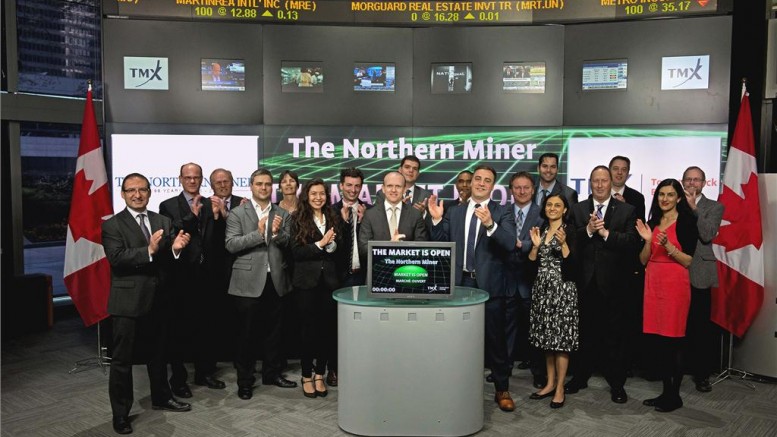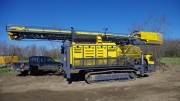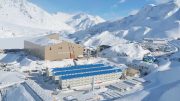The Northern Miner has joined forces again with sister company Infomine to leverage the powerful Intelligence Mine database to outline trends in equity financing for Canadian mining during the most recent market downturn. The study focuses equity raises in 2015, which was a year marked by weak Canadian capital pools on the major stock exchanges.
The data set includes equity financings for mining companies included in the S&P/TSX Venture Composite Index and the S&P/TSX Composite Index during 2015. We then combine this with geographic tagging and commodity statistics to outline broad trends in equity investment over the data period. The study also focuses on where and how companies were spending or investing capital proceeds. Finally, we analyze equity performance subsequent period running through March 2017.
The study is limited to 2015 to ensure that proceeds from equity financing had adequate time to impact equity valuations over a subsequent period. A market capitalization cap was applied to exclude companies with valuations over $3 billion due to the prevalence of alternative financing sources among senior companies, including debt facilities, and streams and royalty packages. Thus the study focuses predominantly on explorers, developers, and intermediate miners.
The capital outlay information is derived by a review of corporate filings, and are therefore reliant on accurate, and transparent, disclosure by the companies involved. The data collected is limited to equity financing with gross total proceeds of at least $700,000.
S&P/TSX Venture Composite Index
The S&P/TSX Venture Composite Index gained nearly 14% over the data period on average trading volumes on the TSX Venture Exchange of 71 million trades per day. The research sample includes 118 equity financings completed in 2015 with gross proceeds totaling $382 million. The equity placements range from $800,000 to $19 million. (There are 977 mining companies listed on the exchange with an average market capitalization of $21 million at the time of writing.)
Financial investment in mining companies listed on the TSX Venture Exchange is traditionally directed to earlier-stage exploration activity, while companies with mineral production, or further down the development curve, tend to graduate to the larger Toronto Stock Exchange.
The first chart breaks down the gross financing numbers into the use of proceeds, or at least the stated intent for proceeds, as communicated in corporate filings for mining companies in the S&P/TSX Venture Composite Index in 2015:
The data shows $274 million, or 72%, of the $382 million raised was directed towards exploration during 2015, with $88 million, or 23%, of the gross proceeds earmarked for development activities. Mergers and acquisitions represent a notably small portion of less than 1% of investment during 2015, which lends support to the idea that cash deals are rarest during market downturns. There was a small element of debt repayment on the TSX Venture Exchange, though early stage companies typically avoid accessing debt markets due to a lack of free cash flow. The development category includes any capital outlays that involve mine design, resource delineation, and regulatory and permitting activities.
Another question that naturally arises is: What commodities saw the largest inflow of investment dollars in 2015 for mining companies in the S&P/TSX Venture Composite Index? The answers are in the following bar chart:
Gold investment stood above all others during 2015 with 66% of gross financing proceeds. The “Other” category encompasses a variety of mineral commodities including potash, phosphate, graphite, rare earths, lead, and molybdenum. It’s notable that lithium investment outpaced zinc and nearly matched copper in our sample. The results speak to the current heightened interest in lithium as a technology metal and align with common narratives in the broader market about chronic under-investment in copper and zinc exploration possibly leading to supply shortages in the longer term for both metals.
Next, we broke down the data geographically to see what regions experienced the most investment in 2015:
The colour saturation on the map indicates the concentration of investment inflows by region. The prevalent “flight from risk” narrative is illustrated in the dominance of investment in North America, which accounted for 66% of equity dollars. There was not much investment interest in South America or Africa during the data period, with the two regions roughly splitting the remaining capital inflows. Around 50% of the investment in Africa and South America was involved in development activities, while 89% of investment in North America was earmarked for exploration.
The final chart for the TSX Venture companies of interest shows the equity performance over 2016 versus equity financing and investment activity during 2015:
The graphic charts equity value growth over 2016 against financing activities in the data period (2015). The bar chart represents average equity growth by companies that invested in specific activities. The red line represents a raw count of total financing earmarked for each activity. Again, exploration represented the largest raw number of financings (91 in total), and experienced the largest average valuation growth over the following year.
Earlier-stage companies also tend to experience the most volatility during down markets. Developers didn’t receive as large a boost in average equity valuation, but also tended not to experience extreme swings during the downturn due to their having some combination of in-situ metal resources, concrete asset valuations, and clearer guidance toward production.
It’s now time to move onto the main S&P/TSX Composite Index and compare investment activities.
The Toronto Stock Exchange’s main index, the S&P/TSX Composite Index gained nearly 4% over 2015 on average volumes of 215 million trades per day. The research sample shows 75 equity financings for mining companies in the S&P/TSX Composite Index completed in 2015 with gross proceeds totaling $1.641 billion, as shown in the next chart. The equity placements ranged from $710,000 to $300 million. (There are 231 mining companies listed on the TSX with an average market capitalization of $1.2 billion at the time of writing.)
The stark difference in the TSX chart compared to the TSX Venture chart is the prominence of debt reduction among the TSX’s larger capitalization companies and producers. The data aligns with common narratives in the mining industry of cyclical over-spending during boom times, followed by a period of debt consolidation and development. It’s also evident that larger companies tend to turn investment and financial activities inward during down markets like 2015, with a focus on in-house development and balance sheet maintenance. Exploration remained a significant investment at 17% of the total, but it was clearly a lower priority than for the juniors companies of the TSX Venture Exchange. And again, the research indicates a general lack of cash being used for mergers and acquisitions in 2015.
The next graphic details the commodities that were targeted in the financing activity of the TSX-listed mining companies in the study:
Gold again dominated the use of proceeds, but copper accounted for a larger portion of activity compared to the TSX Venture companies. Meanwhile, the burgeoning lithium subsector again attracted sizable investment, though capital inflows into alternative commodities (the “Other” category) were notably lower among larger-cap companies. Debt repayment and development focuses were especially prevalent among copper and gold companies, which jointly allocated over $1 billion to those activities. Copper received the largest exploration investment, with capital outflows totaling roughly $135 million.
The next step takes a look at where TSX investments were focused geographically:
Once again, equity investors were seemingly more comfortable providing capital for projects and developments in North America in 2015. In fact, investment in North American gold companies totaled nearly $1 billion over the research period. The map also indicates investment in regions that were not included in TSX Venture capital activity, most notably companies active in Asia, Southeast Asia, and Australia. Total equity investment outside of the Americas, Europe, and Africa totaled around $25 million during the data period.
Lastly, we look at equity valuation movements for these TSX companies:
Despite exploration accounting for lower gross capital investment, it remained prominent in terms of the raw amount of equity transactions. And companies that found capital to invest in exploration during the downturn have done quite well as markets have recovered. Financing earmarked for development initiatives were lower in total quantity, but higher in gross dollar value, and investment in development activities were well rewarded as mineral prices bounced back. Companies that participated in debt reduction experienced greater increases in equity valuation than those that participated in exploration.
In conclusion, the research affirms a number of narratives around the most recent market downturn, showing a retrenchment in exploration expenditures, a focus on debt reduction and internal development pipelines, and a flight from perceived socio-political risk.
— This study is sponsored by PwC Canada, the TMX Group and IntelligenceMine.






Be the first to comment on "TNM Data Miner: Trends in Canadian equity finance and investment"